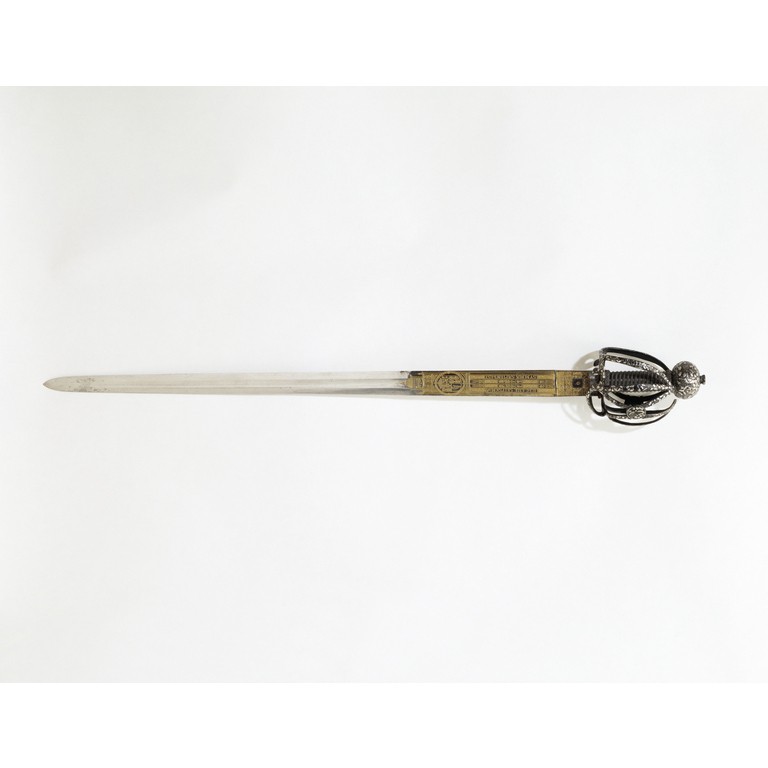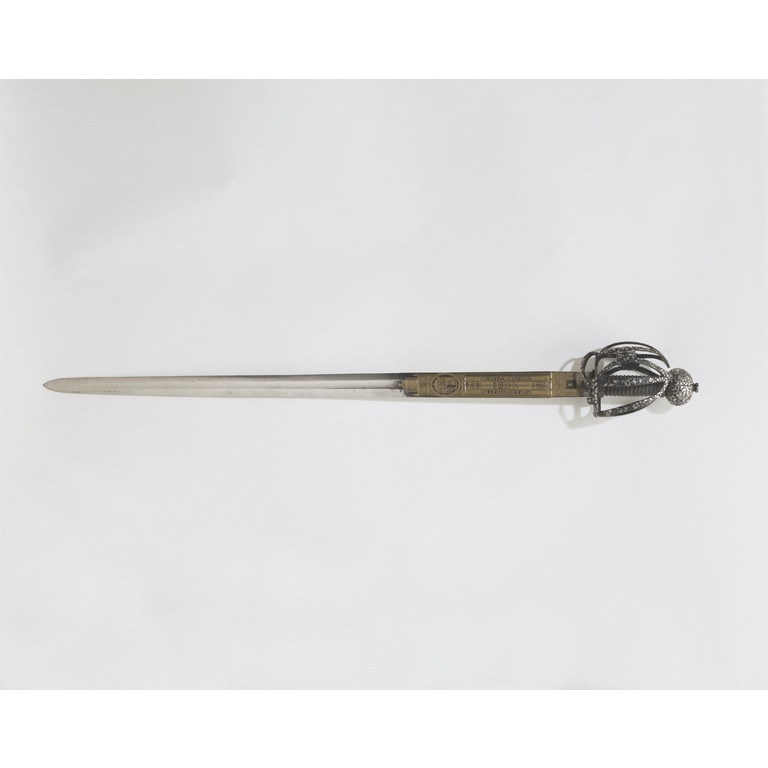| Author |
Message |
Sean Flynt

|
 Posted: Mon 24 Nov, 2008 7:50 am Post subject: Fine English Baskethilt Sword, Ca. 1600 Posted: Mon 24 Nov, 2008 7:50 am Post subject: Fine English Baskethilt Sword, Ca. 1600 |
 |
|
Something special, courtesy the V&A museum.
Date
ca. 1600
Techniques
Silver, engraved and inlaid with gold
Artist/designer
Horn, Clemens, born 1580 - died 1630
Place
Solingen
Dimensions
Height 101 cm (blade and hilt)
Width 12.5 cm (maximum across hilt)
Depth 11.5 cm
Detail
Museum number
M.54-1947
Object Type
This basket-hilt of blackened iron encrusted with silver is of a form known in the early 17th century as an 'Irish' hilt. At that period 'Irish' also meant the Highland Scots, who were celebrated for using a basket-hilted broadsword of similar type. The guard, which protects the hilt, and the pommel, which acts as a counterweight to the blade, are heavily overlaid with silver flowers and foliage. This was a characteristically English type of decoration at this period. The blade is engraved and inlaid in gold with religious mottoes in Latin and the royal arms as used by James I. The design includes a crowned S and an orb and cross - devices used by the cutlers of Solingen.
Trade
The blade is also stamped with a cutler's mark - a unicorn's head. This mark was used by Clemens Horn (1580-1630), one of the most prominent Solingen cutlers. Solingen, in central Germany, had a very large export trade and supplied specially commissioned blades.
People
A number of similarly decorated blades have been recorded, including one in Windsor Castle dated 1617 and traditionally said to have belonged to James I.
Credit line
Bequeathed by Francis Mallett
 Attachment: 90.49 KB Attachment: 90.49 KB

 Attachment: 27.07 KB Attachment: 27.07 KB

 Attachment: 28.34 KB Attachment: 28.34 KB

-Sean
Author of the Little Hammer novel
https://www.amazon.com/Little-Hammer-Sean-Flynt/dp/B08XN7HZ82/ref=sr_1_1?dchild=1&keywords=little+hammer+book&qid=1627482034&sr=8-1
|
|
   |
 |
Thom R.

|
 Posted: Mon 24 Nov, 2008 8:37 am Post subject: most excellent Posted: Mon 24 Nov, 2008 8:37 am Post subject: most excellent |
 |
|
this is excellent thanks so much for sharing..... note that the shields are welded to the bars (rather than integral with the bars) and no ring under the pommel nor attachment to the pommel. classic early 17th c technique. and what a remarkable blade!

|
|
  |
 |
William Goodwin

|
 Posted: Mon 24 Nov, 2008 9:52 am Post subject: Posted: Mon 24 Nov, 2008 9:52 am Post subject: |
 |
|
a beauty indeed Sean....a shame these types of swords don't get more exposure.
cheers,
Bill
Roanoke Sword Guilde
roanokeswordguilde@live.com
"I was born for this" - Joan of Arc
|
|
   |
 |
Sean Flynt

|
|
   |
 |
Nathan Robinson
myArmoury Admin


|
 Posted: Mon 24 Nov, 2008 12:25 pm Post subject: Posted: Mon 24 Nov, 2008 12:25 pm Post subject: |
 |
|
| Sean Flynt wrote: | | It seems to me that it might be possible to achieve a similar look by etching a hilt, bluing it, then polishing the un-etched areas. I wonder if anyone has tried something like that with a reproduction hilt. |
This seems to be similar to what A&A has done for their Elizabethan rapier. It would seem that they cast the hilt, blue it, and polish down the high areas.
Thoughts?

.:. Visit my Collection Gallery :: View my Reading List :: View my Wish List :: See Pages I Like :: Find me on Facebook .:.
|
|
    |
 |
Sean Flynt

|
|
   |
 |
|
E.B. Erickson
Industry Professional
|
 Posted: Thu 27 Nov, 2008 2:47 am Post subject: Posted: Thu 27 Nov, 2008 2:47 am Post subject: |
 |
|
Thanks for posting this, Sean! That's a sword in a very nice state of preservation. For those who'd like to see a similar sword, there's two of them illustrated in the Hayward article in the "Features" section of this website.
--ElJay
|
|
   |
 |
|
|

